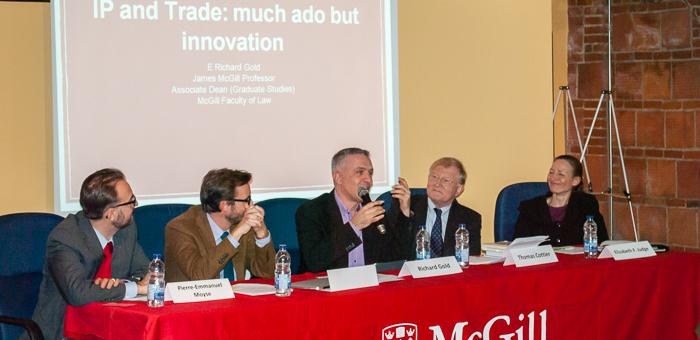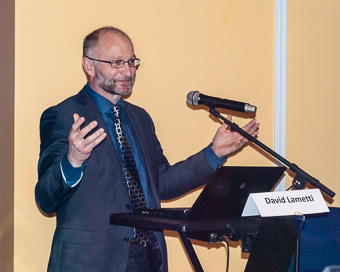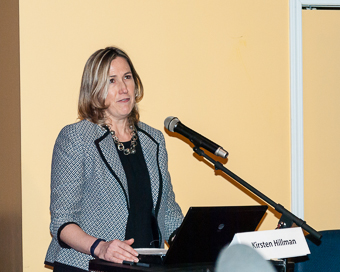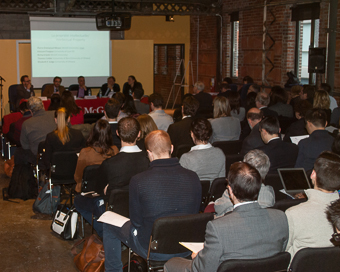The Centre for Intellectual Property (CIPP) and the Centre for International Governance Innovation (CIGI) organized a conference at the end of January to discuss the business, academic and legal impact of the Trans-Pacific Partnership. Stacey Smydo, 3L and a student member of CIPP, provides a recap.

Pierre-Emmanuel Moyse (McGill) chaired the first panel, which featured Edouard Treppoz (Lyon III), Richard Gold (McGill; speaking above), Thomas Cottier (Berne & U Ottawa), and Elizabeth F. Judge (U Ottawa)
Photos by Sharon Webb.
Last week, Minister of International Trade Chrystia Freeland signed the Trans-Pacific Partnership (TPP), a free trade agreement on which Canada’s negotiators have been working for the last three and a half years. Canada now has two years to decide whether or not to ratify the treaty.
The TPP has been a hot topic in recent months and its content is highly controversial. The decision to either ratify the treaty or not will have far-reaching consequences across various sectors of the Canadian economy as several of our largest trading partners are also signatories. Two if its most important chapters cover intellectual property rights and foreign investment.
With a view to contributing to this important conversation, the Centre for Intellectual Property (CIPP), a research centre at the Faculty of Law, together with the Centre for International Governance Innovation (CIGI) organized a conference, attended by over 100 participants, to discuss these issues: “Understanding the TPP: IP Protection and Investment Protection.” The conference was held at CEIM in Montreal’s Quartier de l’Innovation. (See the last edition of Law: Focus Online for a description of some of the other exciting research initiatives taking place at the Centre.)
Panelists and guests included David Lametti, Member of Parliament for LaSalle-Émard-Verdun and Parliamentary Secretary to the Minister of International Trade, and Kirsten Hillman, Canada’s Chief Negotiator for the TPP and Acting Assistant Deputy Minister at Global Affairs Canada, both alumni of the Faculty of Law. The panelists, practitioners and academics alike, hailed from Canada, Switzerland, and Germany, and discussed two chapters of the agreement specifically, but also expanded their inquiries to reflect on broader questions in public international law and governance.

The second panel, which dealt with the protection of foreign investments, was chaired by Armand de Mestral, and brought together Charles-Emmanuel Côté (Laval & CIGI), René Cadieux (Blakes; speaking above), and Marc Bungenberg (U Saarland & CIGI).
 David Lametti gave the keynote address. |
 Kristin Hillman offered the closing remarks. |
 The event, which drew a large crowd, was held at the CEIM, in Old Montreal. The event, which drew a large crowd, was held at the CEIM, in Old Montreal. |
 After the symposium, guests had much to discuss. |
IP PANEL
The first panel of the afternoon examined the intellectual property chapter of the TPP from a variety of perspectives and was chaired by Professor Pierre-Emmanuel Moyse of McGill University’s Faculty of Law and Director of the Centre for Intellectual Property Policy. Professor Edouard Treppoz (Université Lyon III) Professor Richard Gold (McGill University’s Faculty of Law), Professor Thomas Cottier (University of Berne and currently a visiting professor at the University of Ottawa), and Professor Elizabeth Judge (University of Ottawa) discussed a wide range of issues ranging from critical analysis of specific clauses of the treaty to reflections on the purposes of intellectual property rights.
The TPP introduces some new intellectual property rights requirements with which member countries must comply. For instance, the TPP would require Canada to amend its Copyright Act to extend the term of copyright protection from 50 to 70 years after the death of the author and increase criminal sanctions for copyright infringement. There is also a newly articulated commitment to the public domain and transparency (Judge).
Discussion of the intellectual property chapter of the TPP also provided an opportunity to step back and consider the potential social implications of intellectual property rights more generally. Whether intellectual property rights are a good thing at all is itself a contested subject (Gold). So, any intervention in intellectual property policy must try to balance the interests of stakeholders whose interests are helped and hindered by intellectual property rights and this poses a particular challenge to policy makers (Lametti). But, regardless of whether intellectual property rights actually increase innovation or not, the current state of affairs has become entrenched in business practices (Gold) and international agreements such as the TPP entrench these practices on an international scale.
The TPP views intellectual property rights as primarily economic and so, to a certain extent, is inherently inconsistent with the views of many intellectual property rights theorists and practitioners. A treaty focussing on intellectual property rights would have looked very different, possibly engaging in a wholesale reconsideration of intellectual property rights and innovation more broadly as well as creating a vision of intellectual property rights with a greater role for the public (Judge).
INVESTMENT PANEL
Our second panel focused on protection for foreign investment. Chaired by Professor Armand de Mestral of McGill Unviersity’s Faculty of Law, this panel was equally provocative as the first. Professor Charles-Emmanuel Côté (Université Laval) Maitre René Cadieux (Blake, Cassels & Graydon LLP, Montreal) and Professor Marc Bungenberg (University of Saarland) again brought a variety of perspectives and engaged in a lively discussion.
In the wake of WWII, the world was not capable of negotiating a multilateral investment treaty and so made a complex series of bilateral treaties. The TPP represents the convergence in international investment law that could not happen before. Although protection for Canadian investors may now be more onerous, it is not any more complex (Cadieux).
At least for the time being, the TPP will co-exist with numerous other international agreements such as NAFTA and CETA (Côté) and so we have to think about how these agreements will work together. It is possible that actors will use whichever agreement serves their interests (Côté), but this will certainly be a difficult system to navigate. This question in particular inspired some fascinating reflections on fundamental principles of public international law; what is the position of the investor under public international law? Is it a private person or a quasi-subject of public international law? (Bungenberg)
On a related note, the new requirements under both chapters raise the question of enforcement. The TPP members might consider using the WTO dispute settlement mechanisms as it already has the resources and know-how pertinent to making such decisions (Cottier). Some have suggested that a court would be a better solution for trying international investment disputes rather than the current arbitration system. This was met with a variety of responses including concerns for state sovereignty and democratic accountability (Cadieux, Bungeberg).
The TPP is designed to grow and so this overlapping with existing agreements and enforcement mechanisms will become increasingly pronounced. Notably, Europe and its droit de suite and droit moral are entirely absent from the TPP (Treppoz). However, it seems that the TPP is essentially a “non-discussion” in Europe (Bungenberg). On the other hand, the TPP is very much on the radar of several Asian countries who are interested in potentially joining the agreement (Hillman).
CLOSING REMARKS
So. Ultimately, what does the TPP represent for Canada? The TPP is fundamentally a trade agreement and is designed to provide Canadian traders with market access to regions in which Canada has traditionally underperformed, to set clear rules which will enable Canada to flourish, and to allow Canada to compete because several of our main trading partners are signatories. Most sectors of our economy depend on our geographic and business relationships with our trading partners and they are going to go ahead whether we are there or not (Hillman).
Indeed, Canada had two options when the idea of the TPP was first proposed. Although Canada could have decided to wait and see what the agreement might look like before joining, Canada decided to be part of the group making the rules and, the TPP does look very different from when we joined three and a half years ago (Hillman).
The content of the agreement is now set and the question is now whether Canada should ratify the TPP. Consultations with Canadians will continue and will begin to shift towards thinking about implementation. As Professor de Mestral, another treaty negotiator explained, treaties are drafted with particular outcomes in mind, but then they take on a life of their own.
What will be truly interesting will be what happens next…
